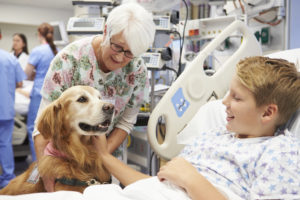 These days, the concept and merit of animal assisted therapy is well known and accepted, even if large-scale research studies on the emotional aspects of the topic are still relatively scarce. It’s hard to pinpoint when the therapeutic potential of animals was first recognized, but many credit Florence Nightingale, an influential figure in the development of modern nursing, with discovering the significant anxiety-reducing effects of small pet animals on children and adults living in psychiatric institutions. In the 1930s, Sigmund Freud nudged the field forward when he began using his Chow, Jofi, during psychotherapy sessions. His findings in turn lent legitimacy to a paper on animal assisted therapy submitted by child psychologist Boris Levinson at an American Psychological Association meeting in the early 1960s.
These days, the concept and merit of animal assisted therapy is well known and accepted, even if large-scale research studies on the emotional aspects of the topic are still relatively scarce. It’s hard to pinpoint when the therapeutic potential of animals was first recognized, but many credit Florence Nightingale, an influential figure in the development of modern nursing, with discovering the significant anxiety-reducing effects of small pet animals on children and adults living in psychiatric institutions. In the 1930s, Sigmund Freud nudged the field forward when he began using his Chow, Jofi, during psychotherapy sessions. His findings in turn lent legitimacy to a paper on animal assisted therapy submitted by child psychologist Boris Levinson at an American Psychological Association meeting in the early 1960s.
Decades later, AAT programs can be found in nursing homes, hospitals, prisons, homes for disabled children, residential treatment facilities, as well as some libraries and schools. And we know for a fact that animals are good for our physical health. By their mere company, they reduce our blood pressure, slow our heart rates, facilitate faster healing, and improve our life expectancy (see, for example, the American Heart Association’s 2013 scientific statement saying that owning a dog lowers the risk of heart disease). But there are strong indications that the positive effect of canine company extends to emotional and mental trauma, too. Dogs seem able to connect with autistic children and patients with Alzheimer’s. Petting a dog is cited by many mental health professionals as a catalyst that can help people otherwise silenced by grief and shock to open up.
But why? The precise biological process behind the effect eludes researchers, but a number of theories exist. One component is a dog’s complete absence of judgment. Calm, well-trained dogs (and other pets) provide gentle physical affection and quiet presence, which allows patients to focus their attention away from internal trauma and external environments—like hospital rooms or psychiatric institutions—that can exacerbate fear and loneliness. Some describe it as a “healing space” accompanying the dog, in which AAT recipients can feel safe and secure, and therefore better able to express themselves and connect with healthcare providers. The takeaway? As research into AAT continues, dogs seem destined for greater recognition as therapeutic partners.

